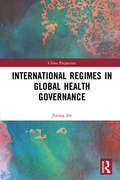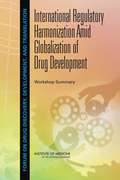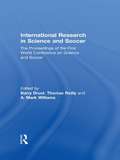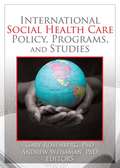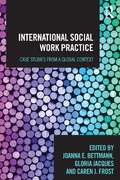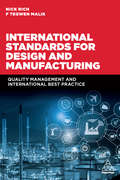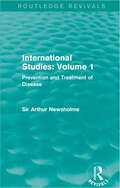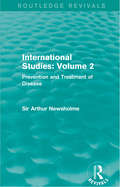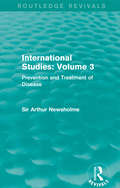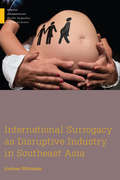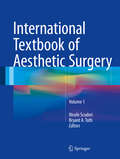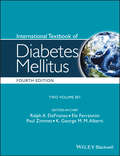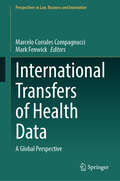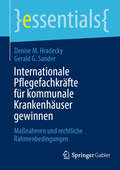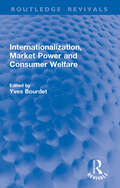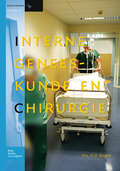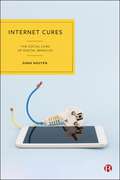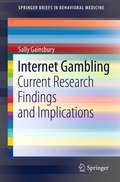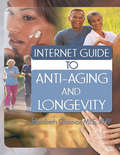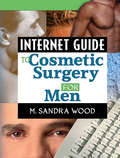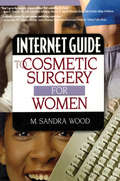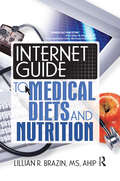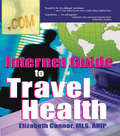- Table View
- List View
International Regimes in Global Health Governance (China Perspectives)
by Jiyong JinBy analysing the roles and problems faced by international regimes as major players in global health governance, this book looks into the root causes of the often insufficient supply of global public goods for health and of the deficiencies in current global health governance. Combining several different methods of analysis and methodologies, this book sketches out the landscape of international public health governance involving a range of international actors. These include the World Health Organization, the World Trade Organization, the Biological Weapons Convention and international human rights regimes. Through a novel theoretical framework that synthesises the theory of securitisation, public goods and international regimes, the author then focuses on factors that have resulted in observed deficiencies in global health governance. Based on these examinations, the book also tries to explore feasible approaches for institutional refinement and innovations for greater effectiveness in global health governance. The book will appeal to academics and policy makers interested in global health, international relations and international law.
International Regulatory Harmonization Amid Globalization of Drug Development
by Institute of Medicine Victoria Weisfeld Board on Health Sciences Policy Tracy A. Lustig Forum on Drug Discovery, Development, and TransitionThe past several decades have been a time of rapid globalization in the development, manufacture, marketing, and distribution of medical products and technologies. Increasingly, research on the safety and effectiveness of new drugs is being conducted in countries with little experience in regulation of medical product development. Demand has been increasing for globally harmonized, science-based standards for the development and evaluation of the safety, quality, and efficacy of medical products. Consistency of such standards could improve the efficiency and clarity of the drug development and evaluation process and, ultimately, promote and enhance product quality and the public health. To explore the need and prospects for greater international regulatory harmonization for drug development, the IOM Forum on Drug Discovery, Development, and Translation hosted a workshop on February 13-14, 2013. Discussions at the workshop helped identify principles, potential approaches, and strategies to advance the development or evolution of more harmonized regulatory standards. This document summarizes the workshop.
International Research in Science and Soccer
by Thomas Barry Reilly A. Mark Williams DrustInternational Research in Science and Soccer showcases the very latest research into the world’s most widely played sport. With contributions from world-leading researchers and practitioners working at every level of the game, from grass roots to elite level, the book covers every key aspect of preparation and performance, including: contemporary issues in soccer coaching psychological preparation and development of players physical preparation and development of players nutrition and recovery talent identification and development strength and conditioning in soccer injury prevention and rehabilitation soccer academies. Sports scientists, trainers, coaches, physiotherapists, medical doctors, psychologists, educational officers and professionals working in soccer will find this in-depth, comprehensive volume an essential and up-to-date resource. The papers contained within this volume were first presented at The First World Congress on Science and Soccer, held in May 2008 in Liverpool, UK. The meeting was held under the auspices of the World Commission of Science and Sports.
International Research in Sports Biomechanics
by Youlian HongThis edited collection of papers presented at the 18th International Symposium of Biomechanics in Sport, highlights cutting-edge research material on sports biomechanics from many of the leading international academics in the field. The thirty-seven chapters presented are divided into nine sections: * biomechanics of fundamental human movement* modelling, simulation and optimisation* biomechanics of the neuro-musculo-skeletal system* sports injuries, orthopaedics and rehabilitation* the application of electromyography in movement studies* biomechanical analysis of the internal load* methods and instrumentation* training* paediatric and geriatric exercise.
International Social Health Care Policy, Program, and Studies
by Andrew Weissman Gary RosenburgNoted experts provide practical, effective strategies to meet global health challengesInternational Social Health Care Policy, Program, and Studies presents a collection of papers drawn from the Ninth Doris Siegel Memorial Fund Colloquium that focuses on social work and international health issues, emphasizing an international exchange and cooperation as a crucial facet of meeting global health challenges. Honoring the memory and spirit of social work pioneer Doris Siegel for her accomplishments and advocacy on behalf of social-health issues, this fine selection of scholarly papers explores ideas and strategies from around the world which offer greater opportunity for success for diverse social work and health care problems. Internationally recognized practitioners and academics offer research and case studies illustrating approaches, programs, and policies that any practitioner or policymaker may find helpful.International Social Health Care Policy, Program, and Studies closely examines the common ground in social health care problems shared by various countries worldwide. Issues such as the effects of terrorism, academic-practice partnerships in practice research, and the international exchange program are explored, with insightful discussions that explain in which directions to best channel social and health care energies and resources. Helpful figures and tables further explain concepts and research.Topics in International Social Health Care Policy, Program, and Studies include: Strength-focused and Meaning-oriented Approach to Resilience and Transformation (SMART) as a model of crisis intervention that uses a holistic view of health outpatient commitment as a delivery system assisted conception and social work needs in the United Kingdom a study on the psychological distress between elderly Israeli residents and immigrant family caregivers impact of prolonged terrorist attacks on children and adolescents in Israel stress experienced by social workers working with terror victims integration of social workers into hospital disaster response teams in Australia academic practice research partnerships for health social workers evaluation of the outcomes from the Mount Sinai Social Work Leadership Enhancement Program discussion of the lessons learned from the 75-year history of health social work in Melbourne, Australia and more!International Social Health Care Policy, Program, and Studies is horizon-expanding reading that is perfect for social workers dealing with a global community, social work libraries, educators, students, and libraries of all types.
International Social Work Practice: Case Studies from a Global Context
by Joanna E. Bettmann Gloria Jacques Caren J. FrostInternational Social Work Practice compares and contrasts divergent social work approaches in countries around the world, providing students with a unique perspective on social work as it is actually practised. Using case studies from frontline practitioners from across the globe, this innovative new textbook stimulates critical thinking about international social work practice issues. Providing a review of both country-specific social work practices and universal social work issues, the text looks at a variety of core social work topics, framed here in terms of CSWE competencies. Set within a theoretical framework presented in the introductory chapter, the subjects covered include: child welfare intimate partner violence family conflict and communication elder care substance abuse trauma. Each chapter presents several case studies exploring range of issues within the broader topic and each case study is commented on by two narratives from social work academics and practitioners from different countries, providing different cultural perspectives. Taking a practical hands-on approach, this text includes a dedicated section for classroom use, with discussion questions, classroom exercises and additional cases for your own analysis. It will be particularly useful to BSW and MSW students taking courses in international social work, practice, social welfare and human behaviour.
International Standards for Design and Manufacturing: Quality Management and International Best Practice
by Professor Nick Rich F. Tegwen MalikInternational standards ensure that organizations operate the right processes to support their objectives. International Standards for Design and Manufacturing is an accessible guide for manufacturing and production managers and students. It guides readers through the standards needed to build operating systems which are robust, integrated and used to drive the continuous improvement of business performance. International Standards for Design and Manufacturing is based on many years of research collaboration between Swansea University and leading manufacturing and production practitioners from key companies from around the world. Each chapter includes an introduction to the standards being discussed, definitions, examples of using the standards in practice, why these standards are important, conclusions, seminar topics and mock exam questions to allow the reader to test their knowledge and understanding.
International Studies: Prevention and Treatment of Disease (Routledge Revivals: International Studies in the Prevention of Disease)
by Sir Arthur NewsholmeFirst published in 1931, this book is the first of three volumes that describe the circumstances of medical work in several European countries at that time. Together, the three books look at public administration, local and national, in relation to the prevention of disease. This first volume focuses on the Dutch, Scandinavian and German speaking countries, as well as Switzerland. It shows that many of these countries have gone beyond most other countries in their in the socialization of medicine in several ways.
International Studies: Prevention and Treatment of Disease (Routledge Revivals: International Studies in the Prevention of Disease)
by Sir Arthur NewsholmeFirst published in 1931, this book is the second of a three volume set which focuses on medical work, and in particular, public administration in relation to the prevention of disease. This volume focuses on the medical circumstances of Belgium, France, Italy, Jugo-Slavia, Hungary, Poland and Czecho-Slovakia. It shows that many of these countries have gone beyond most other countries in their in the socialization of medicine in several ways.
International Studies: Prevention and Treatment of Disease (Routledge Revivals: International Studies in the Prevention of Disease)
by Sir Arthur NewsholmeFirst published in 1931, this book is the third of a three volume set which focuses on medical work, and in particular, public administration in relation to the prevention of disease. This volume provides the most in depth account of the countries it surveys: England and Wales, Scotland, and Ireland.
International Surrogacy as Disruptive Industry in Southeast Asia (Medical Anthropology)
by Andrea WhittakerDuring the last two decades, a new form of trade in commercial surrogacy grew across Asia. Starting in India, a “disruptive” model of surrogacy offered mass availability, rapid accessibility, and created new demands for surrogacy services from people who could not afford or access surrogacy elsewhere. In International Surrogacy as Disruptive Industry in Southeast Asia, Andrea Whittaker traces the development of this industry and its movement across Southeast Asia following a sequence of governmental bans in India, Nepal, Thailand, and Cambodia. Through a case study of the industry in Thailand, the book offers a nuanced and sympathetic examination of the industry from the perspectives of the people involved in it: surrogates, intended parents, and facilitators. The industry offers intended parents the opportunity to form much desired families, but also creates vulnerabilities for all people involved. These vulnerabilities became evident in cases of trafficking, exploitation, and criminality that emerged in southeast Asia, leading to greater scrutiny on the industry as a whole. Yet the trade continues in new flexible hybrid forms, involving the circulation of reproductive gametes, embryos, surrogates, and ova donors across international borders to circumvent regulations. The book demonstrates the need for new forms of regulation to protect those involved in international surrogacy arrangements.
International Textbook of Aesthetic Surgery
by Nicolò Scuderi Bryant A. TothThis two-volume textbook - the result of wide-ranging collaboration among renowned experts in aesthetic surgery from the Americas and Europe - presents state of the art concepts and techniques from across the entire spectrum of cosmetic surgery. It opens with some of the last writings of two of the giants in the discipline, Fernando Ortiz Monasterio and Daniel Marchac, whose contributions set the tone and standard for the rest of the book. In all, there are ten sections covering every aspect of plastic surgery. A very wide range of surgical procedures that can be utilized by the plastic surgeon in training as well as by the established plastic surgeon are described in detail, and in the case of the face, nonsurgical treatments are also fully considered. Further topics include the history of the specialty, legal issues, and anticipated future developments, including regenerative medicine. Numerous beautiful color photographs and skillfully executed illustrations complement the informative text.
International Textbook of Diabetes Mellitus
by George Alberti P. Zimmet E. Ferrannini R. A. DefronzoThe International Textbook of Diabetes Mellitus has been a successful, well-respected medical textbook for almost 20 years, over 3 editions. Encyclopaedic and international in scope, the textbook covers all aspects of diabetes ensuring a truly multidisciplinary and global approach. Sections covered include epidemiology, diagnosis, pathogenesis, management and complications of diabetes and public health issues worldwide. It incorporates a vast amount of new data regarding the scientific understanding and clinical management of this disease, with each new edition always reflecting the substantial advances in the field. Whereas other diabetes textbooks are primarily clinical with less focus on the basic science behind diabetes, ITDM's primary philosophy has always been to comprehensively cover the basic science of metabolism, linking this closely to the pathophysiology and clinical aspects of the disease. Edited by four world-famous diabetes specialists, the book is divided into 13 sections, each section edited by a section editor of major international prominence. As well as covering all aspects of diabetes, from epidemiology and pathophysiology to the management of the condition and the complications that arise, this fourth edition also includes two new sections on NAFLD, NASH and non-traditional associations with diabetes, and clinical trial evidence in diabetes. This fourth edition of an internationally recognised textbook will once again provide all those involved in diabetes research and development, as well as diabetes specialists with the most comprehensive scientific reference book on diabetes available.
International Transfers of Health Data: A Global Perspective (Perspectives in Law, Business and Innovation)
by Mark Fenwick Marcelo Corrales CompagnucciIn an age of digital globalization, navigating the complex landscape of international health data transfers presents significant challenges. This anthology delves into the intricate matrix of regulations, policies, and technologies that govern the transnational flow of health data and provides a comprehensive analysis of the legal frameworks across multiple jurisdictions. This volume sheds light on a range of topics, spanning the multifaceted data transfer mechanisms anchored in the General Data Protection Regulation to the landmark Schrems II court decision that resulted in the invalidation of the Privacy Shield, giving rise to the new Standard Contractual Clauses and the EU-US Data Privacy Framework. These seminal events triggered reforms not just in Europe and the US but have had far-reaching effects on global policy frameworks. In light of these developments, the book explores the contemporary regulatory shift spanning countries from the Global North and Global South. This comprehensive exploration encompasses a diverse array of nations, from the European Union, United Kingdom, United States, Japan, South Korea and Taiwan, to China, Australia, Nigeria, Colombia and India. With insights from leading experts and enriched by global case studies, this collection offers a holistic view of the evolving dynamics in international health data transfers. The book provides an indispensable resource for policymakers, legal scholars, healthcare professionals, and technology enthusiasts traversing the intersection of law, ethics, and global health data in the 21st century.
Internationale Pflegefachkräfte für kommunale Krankenhäuser gewinnen: Maßnahmen und rechtliche Rahmenbedingungen (essentials)
by Gerald G. Sander Denise M. HradeckyDieses essential bietet eine Analyse staatlicher Maßnahmen zur Bewältigung des Pflegekräftemangels, darunter das Pflegepersonal-Stärkungsgesetz, das Pflegeberufegesetz und das Fachkräfteeinwanderungsgesetz. Es beleuchtet auch das Pflegestellen-Förderprogramm und Initiativen wie „Faire Anwerbung Pflege Deutschland“ des Bundesgesundheitsministeriums. Zudem werden die Rekrutierungsbemühungen kommunaler Krankenhäuser im Hinblick auf ausländische Pflegefachkräfte sowie die rechtlichen Anforderungen thematisiert. Darüber hinaus werden Fragen zur Anerkennung ausländischer Pflegeberufsqualifikationen und Berufsabschlüsse behandelt. Die strukturierte Darstellung erläutert die besonderen Herausforderungen des Pflegekräftemangels und präsentiert staatliche, institutionelle und rechtliche Lösungsansätze.
Internationalization, Market Power and Consumer Welfare (Routledge Revivals)
by Yves BourdetIn the years prior to this book being originally published in 1992, the study of industrial economics had been dominated by the USA. While there was a fund of theoretical and empirical knowledge relating to the US experience, this is not always relevant in the context of Europe. With its considerable national market the USA developed competition policies that differ from those in the smaller economies of European countries.This collection of essays looks at the market behaviour of an economy more open to international competition. The industrial organization of Sweden provides the ideal representation of smaller economies that can be applied to the other economies of western Europe.The contributors apply different analytical approaches to assess direct and indirect forms of market power. Some papers draw on econometric cross-sectional models exploring the scope of market power and the role of international competition. Others look at specific markets investigating the formation of market power – its costs to consumers and the role of lobbying groups and the political sphere: case studies include the domestic car, white goods, pharmaceutical goods, food, textile and air transport markets. The book also contains papers that examine the role of competition policy towards restrictive practices and mergers in curbing market power and promoting economic efficiency.This book will be of interest to those studying industrial economics and international business and marketing.
Interne geneeskunde en chirurgie
by Ij. D. JüngenIn dit boek wordt de basis gelegd voor een goed begrip voor de interne en chirurgische ziektebeelden, samen met de basiswerken Anatomie en fysiologie en Algemene ziekteleer, die hierop aansluiten.et toedienen, verdunnen en oplossen van geneesmiddelen in de patiëntenzorg. Het boek begint met het hoofdstuk medisch meedenken. Bij alle onderdelen van het diagnostisch proces spelen verpleegkundigen een belangrijke rol. Aan de hand van casuïstiek wordt verhelderd hoe het diagnostisch proces verloopt en hoe verpleegkundigen hierin een rol kunnen en moeten spelen. In de volgende hoofdstukken worden de verschillende meest voorkomende ziektebeelden met hun verschijnselen, complicaties en behandeling naar orgaansysteem beschreven. Steeds wordt geprobeerd om de verschijnselen en complicaties vanuit de fysiologie te verklaren, zodat de verpleegkundigen beter kunnen observeren (wat kan men observeren, hoe kan men observeren en met welk doel wordt geobserveerd) en daardoor beter kunnen signaleren en beredeneren welke verpleegkundige interventies noodzakelijk zijn.
Internet Cures: The Social Lives of Digital Miracles
by Dang NguyenIn health care, we come across daily promises of miraculous cures for various ailments. However, in the digital era, the dynamics of experiencing and practicing these remedies have changed. This book explores the intersection of miracle cures and technology, showcasing their transformation into hybrid forms, such as handwritten recipes captured in photos or tutorials streamed through videos. Combining computational social media data with ethnographic insights from Vietnam and the US, the book captures the interconnected lives of these cures in the digital realm with a unique methodology. Unravelling the intricate connections between social, technological, biomedical and non-biomedical spheres, this is a significant contribution to how social scientists study online media.
Internet Gambling
by Sally GainsburyInternet gambling is one of the fastest growing forms of gambling. Global Internet gambling expenditure is predicted to reach US$33.6 billion in 2011. This is higher than worldwide movie box office revenues and represents 9% of the international gambling market. The rapid increase in expenditure of 354% since 2003 has occurred despite Internet gambling being prohibited in several key markets, including the US and China. It also suggests that current regulation may be somewhat outdated and ineffective as more and more people turn to this mode of gambling. Internet gambling is highly accessible with over 2,400 sites available 24/7 through computers, mobile phones, wireless devices and even interactive televisions. Gamblers can now play casino games, bingo, cards and poker, bet on races, sports and even celebrity weddings using over 199 means of electronic payments without leaving the house. Increasing international jurisdictions are legalizing Internet gambling and the constant accessibility of online gambling has critical social implications. Gambling operators are using aggressive advertising campaigns to move into new markets. Internet gambling appears to be particularly appealing to youth, who are gambling online at substantially higher rates than adults. Furthermore, Internet gambling appears to be related to problem gambling, with rates of problem gambling three to four times higher among Internet than non-Internet gamblers, indicating that it may have a substantial social cost. The anonymity of online sports betting poses a significant threat to the integrity of sport at all levels with increasing allegations of match-fixing and cheating. Estimates suggested that 50% of all bets on the 2010 FIFA World Cup were placed online, worth an estimated £500 million. These figures represent a 700% rise in online betting since the 2006 tournament and included many new players that opened online accounts. It is essential that appropriate responses are made by governments, industry professionals and the public in response to Internet gambling. This book will provide a comprehensive and up-to-date overview of Internet gambling, including the social impact and regulatory options. A global outline will include the characteristics and features of the many forms of Internet gambling, including the current market, and participation, and differences between Internet and non-Internet gambling. Specific regional considerations will be explored including regulatory responses and options. Importantly, the social consequences and costs of Internet gambling will be examined, including the impact of online gambling on sports, youth and problem gambling. Strategies for prevention and responsible gambling will be considered as well as expected trends.
Internet Guide to Anti-Aging and Longevity
by Elizabeth ConnorQuickly and easilyfind anti-aging and health strategies on the Internet Even the most sophisticated Web surfer can become frustrated searching for specific health information on the Internet. The Internet Guide to Anti-Aging and Longevity tackles this problem by providing a comprehensive compilation of annotated links on health,
Internet Guide to Cosmetic Surgery for Men
by M. Sandra WoodSave time and trouble as you search the Internet for safe and reliable information on cosmetic procedures In a culture where everyone wants to look younger, more and more men are going under the knife for surgical cosmetic procedures in an effort to turn back the clockor at least slow it down a little. The Internet
Internet Guide to Cosmetic Surgery for Women
by M Sandra WoodLearn to use the Internet to find important information on cosmetic surgery procedures-and the right surgeon to do it!Hundreds of thousands are considering cosmetic surgery of some sort. The question is where can you go to find out what is right for you? The Internet Guide to Cosmetic Surgery for Women gives you the advantage of finding out everything you want to know about cosmetic surgery-from the comfort and privacy of your own home. This comprehensive resource guides you through the mountains of information on the Internet, providing a thorough listing of Web sites detailing every aspect of plastic and cosmetic surgery for every body part, as well as presenting strategies for finding specific information you are looking for. The Internet Guide to Cosmetic Surgery for Women gives you the tools to find information about a specific procedure, learn the surgery&’s advantages as well as risks-even how to locate the best surgeons for the procedure. The book provides screen shots to illustrate Web sites, information on where to find the latest important statistics and data, and helpful definitions for cosmetic surgery terms.The Internet Guide to Cosmetic Surgery for Women not only lists Internet addresses and basic sites on cosmetic surgery, but also reveals where to find quality information on: the costs of surgery selecting a cosmetic surgeon liposuction calf implants tummy tucks thigh lifts buttock liposculpture buttock augmentation belt lipectomy breast surgeries, including enlargement, lifts, reconstruction, and reduction cheek implants facelifts jaw augmentation laser skin resurfacing lip augmentation nose surgery cellulite treatment Botox injections hair removal hair transplantation scar revision wrinkle treatment chemical peels cosmetic dentistry and much more!The Internet Guide to Cosmetic Surgery for Women is an essential guide for anyone interested in or considering plastic and cosmetic surgery procedures.
Internet Guide to Medical Diets and Nutrition
by Lillian BrazinDon't waste you time with health and diet Web sites that don’t work. The Internet provides unlimited resources that make it easy to learn about various diets, weight-loss programs, and weight-reduction procedures. But with so many sources, which ones can you trust for information that’s safe, accurate, and up-to-date? The Internet Guide to Medical Diets and Nutrition saves you time, trouble, and effort in your search for Web sites that offer the facts about diet programs and nutrition philosophies that meet your health, medical, or religious needs. The Internet Guide to Medical Diets and Nutrition helps you filter out Web sites that offer little, if any, real help in maintaining special diets that address specific diseases (low protein, high calcium, low gluten, hypoallergenic, diabetes, cancer, anemia, etc.), religious or philosophical mandates (Hindu, kosher, vegan, Muslim, macrobiotic, etc.), or commercial regimens (Atkins™, Weight Watchers®, NutriSystem®, etc.), or provide answers to questions about bariatric surgery (gastric bypass, stomach stapling, etc.). This invaluable reference resource teaches you how locate Web sites recommended to you, how to evaluate the information you find there, how to research a particular diet or health concern, how to choose and use the right search engine, the significance of domains in Web addresses, and how to observe proper etiquette when participating in Internet discussion groups. Topics examined in the Internet Guide to Medical Diets and Nutrition include: general diet and nutrition Web sites Web calculators (Body Mass Index, exercise, calories, weight-maintenance, healthy weight) the nutrient content of foods food labels non-surgical weight-loss Web sites caloric restrictions hypnosis weight-loss centers and workshops weight-loss surgery Web sites Web sites for specific medical conditions vegetarianism recipes online discussion groups and much more! The Internet Guide to Medical Diets and Nutrition also includes a glossary of terms and screen captures of important Web sites. The book is a must-have as an everyday resource for consumers with diet and health interests and concerns, and as a reference tool for medical and public libraries.
Internet Guide to Pet Health
by Elizabeth ConnorWith the staggering amount of pet health information available on the Internet, it is often difficult to find exactly what you are looking for. The Internet Guide to Pet Health is a one-stop guide that weeds through all the clutter to bring you only the most dependable sources and relevant content. This comprehensive compilation of annotated links will serve as a handy, useful, and easy-to-consult guide for persons who appreciate animals and/or own domestic pets of all kinds, especially cats and dogs. This text also features a full glossary of medical terms, bibliography, and a quick-find index.The health needs of pet animals have become as complex and specialized as those of humans. Pet owners, veterinarians, and animal lovers alike need authoritative, reliable, and up-to-date information about caring for the health and well-being of pets. The Internet Guide to Pet Health offers a quick, easy, and comprehensive reference to quality Web sites that focus on the health and welfare of animal companions. The Internet Guide to Pet Health will help you pinpoint reliable information on: • the health benefits of pet ownership • diseases transmitted by pets • pet food safety • animal care and welfare societies and organizations • death, dying, and euthanasia • poisons, dangerous situations, and other hazards • spaying and neutering • traveling with pets • pet-specific care for dogs, cats, small animals, and fish • surgery, surgical procedures, and hospitalization • exercise and training • dental care, diet, and nutrition • disabled pets • service and therapy animals • and much, much more! The Internet Guide to Pet Health is an ideal resource for anyone who is directly involved in the lives of pet companions or simply an animal lover. Medical librarians in academic medical centers and teaching hospitals; consumer health and public librarians; veterinarians and veterinary clinic staff; public health personnel; animal trainers; and groomers will also find this to be an invaluable text.
Internet Guide to Travel Health
by Elizabeth ConnorDiscover the best Web sites for you and your family&’s well-being while traveling! The Internet Guide to Travel Health is your one-stop resource for when you need authoritative, reliable, and up-to-date information for preventing or dealing with illness and injury while traveling in the United States and abroad. For persons traveling near or far, this useful, easy-to-consult guide identifies dependable Web sites with advice, tips, and accurate facts on health issues that can affect your travel plans. You&’ll save time and effort when researching the planning, preparation, and preventive measures necessary to stay healthy while traveling. In the Internet Guide to Travel Health, you will discover a wealth of information for maintaining your health and safety throughout your trip. This book offers you Web sites to keep you informed on the latest life-threatening situations occurring throughout the world, such as disease outbreaks, epidemics, and natural disasters. With Internet addresses for what health documents to keep with you at all times, how to find doctors and clinics at your destination, and even what to do in case of a death far from home, this informative guide helps you stay organized, even in an emergency. The Internet Guide to Travel Health provides you with reliable information on: elective and compulsory immunizations, vaccinations, and examinations safety concerns with specific modes of travel-automotive, railways, air travel, cruise ships travel recommendations and accommodations for people with disabilities, seniors, children, people with HIV, and pets specific diseases, conditions, and ailments that can affect travel or be encountered while traveling-from air rage and allergies to West Nile Virus and Yellow Fever interactive tools and real-time travel advice-driving distance calculators, air flight arrival/departure delays, and traffic reports In addition to the Web site listings, the Internet Guide to Travel Health provides numerous screen shots of key Internet resources and an understandable glossary of health- and Internet-related terms. With the myriad of health and safety risks associated with traveling both nationally and internationally, this book is essential for vacationers, business travelers, explorers, and health care professionals who want to stay informed and prepared.
